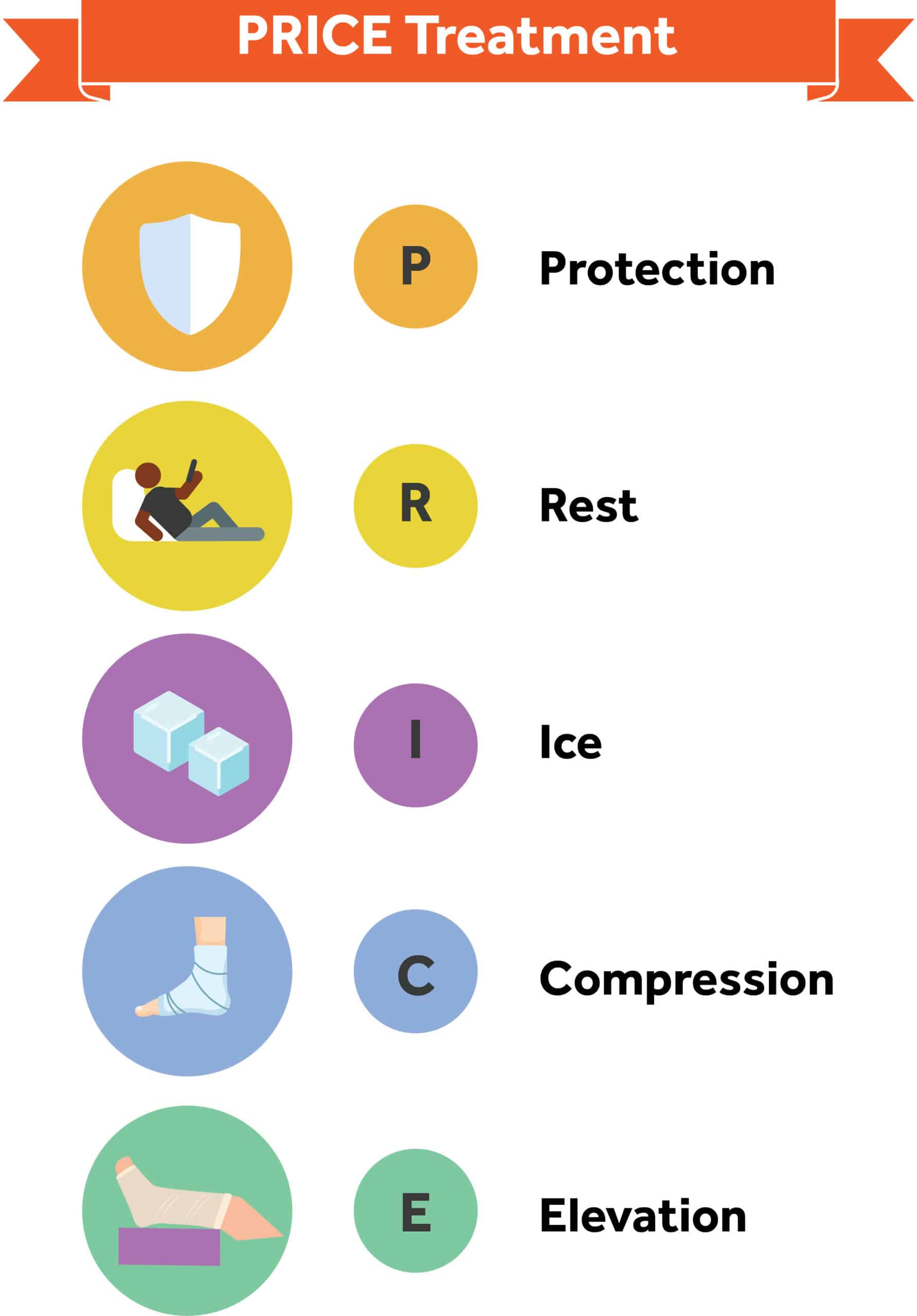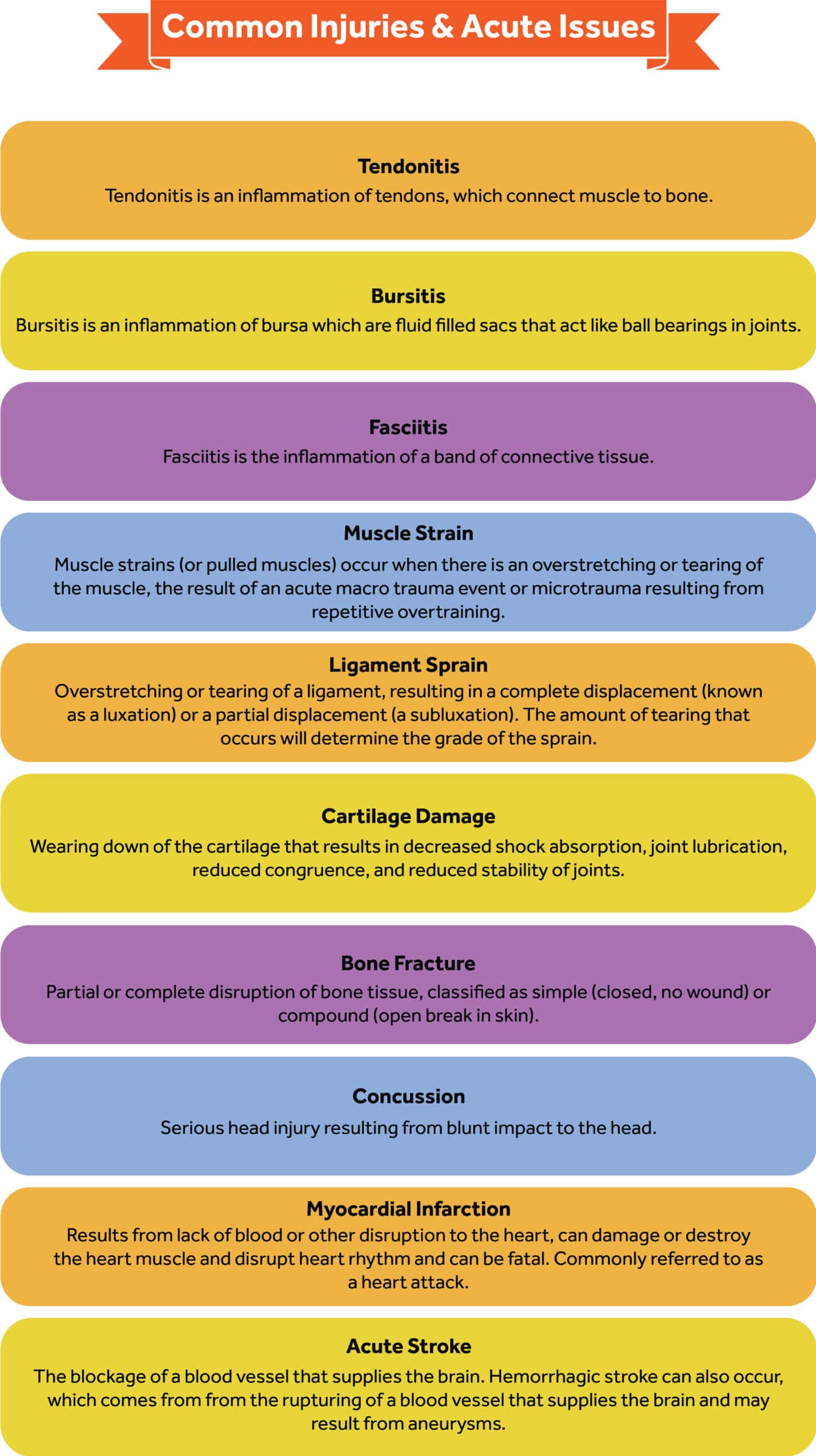Keeping clients safe from injury and fitness professionals free from legal issues is paramount when training a client in any scenario. Fitness professionals must respond appropriately to emergency situations, understand the various injuries relevant to personal training, and maintain a safe training environment.
Introduction to Emergency Situations
CPR/AED Importance
All fitness professionals must maintain an up-to-date adult CPR/AED certification, and ideally, first aid and infant CPR as well. Often, training facilities require all staff to have these certifications, and may provide certification classes. These certifications cover the steps to take in the event of a cardiac emergency or other first aid emergency situations.
Dealing with a cardiac emergency, such as a cardiac arrest where the heart stops, or a deadly arrhythmia such as ventricular fibrillation (VF), requires immediate action. Response time can mean the difference between life or death. The time between calling 911 to activate the EMS and the arrival of medical personnel may be longer than the victim will survive.
All training facilities should have an Automated External Defibrillator (AED) available, which drastically improves the effectiveness of CPR.
Emergency Safety
Before responding to any emergency, particularly when bodily fluids are involved, responders should wear personal protective equipment (PPE), which includes medical gloves, mask or face shield, eye protection, and if performing CPR, a CPR facemask. PPE is vital to protect the responding individual from various communicable diseases including hepatitis and HIV.
CPTs must wear gloves whenever there is a need to touch anyone to deliver emergency care. They should have a face shield with a one-way valve to protect themselves when giving rescue breaths during Cardiopulmonary Resuscitation (CPR). Following the standards of Universal Precautions and treating all bodily fluids as a biological hazard is imperative. This will protect CPTs from blood borne pathogens like Human Immunodeficiency Virus (HIV) and Hepatitis.
When responding to an emergency, fitness professionals should always call 911 or activate the facility’s emergency procedures, then provide appropriate care within the scope of their training. The fitness professional should not attempt to give care beyond the scope of any certifications they have. Since fitness professionals must be CPR certified, responding to cardiac emergencies and related conditions is within the Trainer Academy Certified Personal Trainer Scope of Practice.
Acute Injuries
Personal trainers may encounter clients with injuries to various tissues of the body like muscle, tendons, ligaments, cartilage, and bones. These injuries may be pre-existing, but can also occur during the exercise session, particularly if the client misses a key form checkpoint or fails a heavy lift.
Pre-existing injuries and risk factors are screened via the health history and PAR-Q forms and discussed between the trainer and client prior to beginning any exercise.
Clients with a history of soft tissue injury should undergo rehabilitation under the supervision of a physical therapist prior to working with a fitness professional. However, many clients will have low grade, nagging injuries that may or may not be rehabilitated. In this case, any movement that causes pain should be avoided, and corrective exercises should be used to address any obvious muscular imbalances.
Diagnosing or treating any injury is outside the Trainer Academy Certified Personal Trainer Scope of Practice, but being able to identify and respond appropriately to common injuries such as strains, sprains, and fractures is an important skill. The appropriate response to injuries should be to contact emergency medical personnel, begin the PRICE treatment, and refer the client to the appropriate healthcare professional once the acute situation has been addressed.
The PRICE Treatment
The PRICE treatment is an acute process for addressing tissue injuries and consists of the following1:
- Protection
- Rest
- Ice
- Compression
- Elevation
Protection involves preventing further injury by removing the stress to the injured area. Rest or restricted activity, especially weight bearing involves inactivity to the injured area, but not necessarily complete bed rest.
Ice should be applied 10-20 minutes every hour for 24-72 hours. Ice will reduce pain and inflammation. Trainers should not apply ice directly to the skin surface; have a cloth or some type of barrier between the ice and skin. Compression is achieved by putting a compression wrap that covers above and below the injured area. Elevation is accomplished by raising the injured body part 6-12” above the heart. This helps to reduce inflammation.

Regardless of the type of musculoskeletal injury the tissues will go through 3 stages of healing. The stages are2:
- Inflammation
- Repair
- Remodeling
During inflammation, which may last for up to six days depending on the severity of the injury, the goal is to immobilize the area to prevent further injury and to prepare the tissue for healing during the subsequent phases. Rest, ice, compression, and elevation are recommended at this stage.
The repair phase begins approximately three days after the injury and may last for up to twenty-one days. During this stage damaged tissues are healed and replaced, and scar tissue is formed. New connective tissue is laid down. Collagen, which is the component of the new connective tissues and strongest when parallel to the line of stress, is laid down in a transverse alignment, which does not allow for optimal strength of the new tissue.
The goals during this stage are to prevent muscle atrophy, joint degeneration, promote collagen resynthesis, and prevent damage to newly formed collagen fibers. During this stage low load stresses may be used cautiously to prevent loss of joint motion and to promote collagen synthesis.
The phase of remodeling begins around day twenty-one and may last up to two years. The goal during this phase is to strengthen the newly formed tissue by helping the collagen fibers to align in parallel. Increased loading may be used to help the newly formed collagen fibers to strengthen and line up parallel to the line of stress. During this phase clients may continue exercises performed during the repair phase and activity specific exercise may be added.
The rehabilitation process above is generally beyond the scope of personal training and should be overseen by a licensed physical therapist.
Common Injuries and Issues
Tendonitis/Bursitis/Fasciitis
Tendonitis, bursitis, and fasciitis are inflammatory conditions that typically result from repeated microtrauma caused by overuse.
Tendonitis is an inflammation of tendons, which connect muscle to bone.4,6 Bursitis is an inflammation of bursa which are fluid filled sacs that act like ball bearings in joints.3,4 Fasciitis is the inflammation of a band of connective tissue.4,5
These injuries often occur from repeated microtrauma or overuse. The repetitive stress causes inflammation of the respective tissues. Insufficient warm up, overtraining, and previous injury can be underlying causes.
General symptoms of these three conditions include localized pain, pain with activity, and weakness. Proper response and treatment consist of conservative management which includes rest, avoidance of contraindicated activities, ice, heat, physical therapy, anti-inflammatory medication, and cortisone injections. Ice should be used initially before heat.
If any of these inflammatory conditions is suspected, the fitness professional should refer the client to the appropriate professional.
When the injury is stabilized, heat may be used before activity and ice may be used after activity. If there is severe pain, loss of function, or the injury doesn’t respond to conservative treatments in 2-4 weeks, a doctor referral is recommended. Program modifications to restore strength, muscle balance, and flexibility along with a proper warm and myofascial release techniques of the area are recommended.
Muscle Strain
Muscle strains (or pulled muscles) occur when there is an overstretching or tearing of the muscle.
Strains may be the result of an acute macro traumatic event or microtrauma resulting from repetitive overtraining. In either case, the result is pain, inflammation, and possible loss of function.7
Overtraining can be defined as what occurs when intensity, duration, and frequency exceed the adaptation capacity.
The symptoms and grievousness are dependent on the grade of the strain.
- Grade 1 strains are mild with tears occurring to only a few fibers with the muscle being painful and tender.
- Grade 2 strains are a moderate tear with a greater number of fibers being affected. This results in pain, point tenderness, inflammation, bruising, mild swelling, and noticeable loss of function.
- Grade 3 strains are complete tears of the muscle that result in loss of function, extreme pain, point tenderness and inflammation along with bruising.
Initial response for strains involves the PRICE acronym. A physician’s referral may be warranted depending on the grade of the strain.
Risk factors for strain in the fitness context include improper warm up, muscle fatigue, muscle imbalance, poor flexibility, bad posture, and fluid and electrolyte depletion. Painful activities will have to be avoided and exercise programs will need to be modified to promote strengthening, muscle balance, and flexibility to the strained muscle.
Since muscles, tendons, and ligaments respond to the stress or lack thereof put on them, long periods of immobilization are detrimental to healing and can lead to atrophy. Full recovery time for muscle strain depends on the grievousness of the strain, the muscle injured, and length of immobilization. Common areas for muscle strains are the shoulder, hamstring, knee, hip, and calf.
Suspected strains should be assessed by a qualified medical professional prior to resuming training with the injured area.
Ligament Sprains
Ligaments connect bone to bone and provide stability for joints. A sprain is an overstretching or tearing of a ligament. This may result in a complete displacement (known as a luxation) or a partial displacement (a subluxation). The amount of tearing that occurs will determine the grade of the sprain.8
- Grade 1 sprains are minimal tears that result in minor swelling, pain, and loss of function.
- Grade 2 sprains result in the complete tearing of some but not all fibers resulting in moderate pain, swelling, and loss of function.
- Grade 3 sprains are complete tears and rupture of the ligament resulting in severe pain, swelling, and loss of function.
Sprains are serious injuries that require qualified medical care and warrant stopping activity until examined by a surgeon.
Return to activity will be dependent on the grade and location of the sprain. Exercise programs should be modified to continue progressing what was done in physical therapy. Sprains commonly occur in the shoulder, knee, and ankle.
Cartilage Damage
Cartilage provides shock absorption, lubrication, improves congruence, and increases the stability of joints. The primary cartilage structures of concern to fitness professionals are the medial and lateral menisci of the knee which may become worn from degeneration or damaged by a traumatic event. Symptoms include medial and lateral instability of the knee, pain, stiffness, and complaints of hearing a clicking sound with weight bearing activity.9
Chondromalacia a wearing away of the cartilage behind the patella is another source of complaints. It is the result of improper tracking of the patella on the femoral groove. Pain occurs behind the patella and walking up and down stairs exacerbates the symptoms.
Cartilage injuries should be assessed by a qualified medical professional prior to resuming training with the injured area.
Bone Fracture
A partial or complete disruption of bone tissue is known as a fracture. A fracture is classified as simple (closed) or compound (open). A simple fracture is one where there is no break in the skin while a compound fracture will result in breakage of the skin. Different types of fractures include longitudinal, oblique, transverse, and compression.
Concussions
Concussions are a serious head injury resulting from blows to the head. Loss of consciousness may occur, and the first signs are confusion and disorientation. Other symptoms include amnesia, headache, drowsiness, impaired speech, tinnitus, double vision, and sensitivity to light or noise. After a concussion the person is in a vulnerable state and a second injury could be disabling. A client suspected of having a concussion should receive immediate medical attention and cease physical activity immediately.11
Myocardial Infarction
Fitness professionals must be very familiar with the signs of myocardial infarction (heart attack) and stroke.
Angina pectoris is pain in the chest described as a crushing and squeezing feeling that is sometimes mistaken for indigestion. The pain can radiate to the neck, jaw, shoulder, or stomach as well as down the arms, especially the left arm since the heart is on that side of the chest. Clients experiencing angina pectoris may be having a heart attack and should be carefully monitored and receive qualified medical attention. This is particularly true if the client has risk factors for cardiovascular disease.12
Other symptoms of heart attack include vomiting, nausea, and cold sweats. Dyspnea or labored breathing that results in shortness of breath is possible as well. The symptoms may occur without chest pain. Screening clients ahead of time to ensure at-risk clients are carefully monitored is vital for ensuring client safety.12
Acute Stroke
Stroke is a leading cause of disability. Most strokes are ischemic and result from blockage of a blood vessel that supplies the brain. The other type of stroke is hemorrhagic and results from the rupturing of a blood vessel that supplies the brain. This may result from aneurysms, which are weak spots in the artery that form a balloon like bubble.13
Warning signs to look for include if the person is off-balanced when they walk, if they have slurred speech, droopy face, weakness, or numbness on one side of the body, partial or total vision loss, and severe headache.13
Symptoms will also be dependent on which side of the brain is affected. If the right side is affected the right side of the face and left side of the body will be affected. Weakness, numbness, vision, and memory loss may occur. When the left side of the brain is affected, the left side of the face and right side of the body will be affected. Weakness, paralysis, and speech and language impairments may be visible signs of stroke.13
An individual suffering a stroke requires immediate medical attention from qualified professionals.

Gym Maintenance and Hygiene
Client care and customer service are an integral part of personal training services. Fitness professionals must take all measures to ensure cleanliness and safety. Facilities and equipment should be clean, maintained and properly functioning. While fitness professionals may not be tasked with equipment maintenance, any observed malfunction, issue, or defect in equipment should be promptly reported and the equipment should not be used.
Trainers should make sure to wipe down equipment including mats after use. Hand sanitizer or wipes should be available to prevent the spread of any infections.
As a precaution it would be wise for coaches to wipe equipment before use too. Gym hygiene is everyone’s responsibility, but personal hygiene is up to the individual trainer. The first impression a client gets of their fitness trainer may be based on appearance and demeanor.
A good trainer needs a professional standard and appearance. One way to do that is by being professionally dressed and groomed. Wiping down and cleaning equipment prevents the spread of disease, shows that they care and respect the people and place they work at.
Summary
Fitness professionals must be prepared to respond appropriately to a variety of potential emergency situations that may occur in the personal training environment. Emergency medical personnel should always be called in the event of a life threatening emergency. Since Trainer Academy Certified Trainers are required to be CPR certified, they may respond to cardiac emergencies per their training.
References
- Norton C. How to use PRICE treatment for soft tissue injuries. Nurs Stand. 2016;30(52):48-52. https://doi.org/10.7748/ns.2016.e10506
- Essentials of Strength Training and Conditioning. Tissue healing. National Strength and Conditioning Association(NSCA). https://www.nsca.com/education/articles/kinetic-select/tissue-healing/. Published December 22, 2021. Accessed November 2, 2022.
- Williams CH, Jamal Z, Sternard BT. Bursitis. [Updated 2022 Jul 24]. In: StatPearls [Internet]. Treasure Island (FL): StatPearls Publishing; 2022 Jan-. Available from: https://www.ncbi.nlm.nih.gov/books/NBK513340/
- Huang HH, Qureshi AA, Biundo JJ Jr. Sports and other soft tissue injuries, tendinitis, bursitis, and occupation-related syndromes. Curr Opin Rheumatol. 2000;12(2):150-154. https://doi.org/10.1097/00002281-200003000-00009
- Buchanan BK, Kushner D. Plantar Fasciitis. [Updated 2022 May 30]. In: StatPearls [Internet]. Treasure Island (FL): StatPearls Publishing; 2022 Jan-. Available from: https://www.ncbi.nlm.nih.gov/books/NBK431073/
- Bass E. Tendinopathy: why the difference between tendinitis and tendinosis matters. Int J Ther Massage Bodywork. 2012;5(1):14-17. https://doi.org/10.3822/ijtmb.v5i1.153
- Noonan TJ, Garrett WE Jr. Muscle strain injury: diagnosis and treatment. J Am Acad Orthop Surg. 1999;7(4):262-269. https://doi.org/10.5435/00124635-199907000-00006
- Yang G, Rothrauff BB, Tuan RS. Tendon and ligament regeneration and repair: clinical relevance and developmental paradigm. Birth Defects Res C Embryo Today. 2013;99(3):203-222. https://doi.org/10.1002/bdrc.21041
- Bhan K. Meniscal Tears: Current Understanding, Diagnosis, and Management. Cureus. 2020;12(6):e8590. Published 2020 Jun 13. https://doi.org/10.7759/cureus.8590
- Sop JL, Sop A. Open Fracture Management. [Updated 2022 Aug 8]. In: StatPearls [Internet]. Treasure Island (FL): StatPearls Publishing; 2022 Jan-. Available from: https://www.ncbi.nlm.nih.gov/books/NBK448083
- Tator CH. Concussions and their consequences: current diagnosis, management and prevention. CMAJ. 2013;185(11):975-979. https://doi.org/10.1503/cmaj.120039
- Mechanic OJ, Gavin M, Grossman SA. Acute Myocardial Infarction. [Updated 2022 Aug 8]. In: StatPearls [Internet]. Treasure Island (FL): StatPearls Publishing; 2022 Jan-. Available from: https://www.ncbi.nlm.nih.gov/books/NBK459269/
- Tadi P, Lui F. Acute Stroke. [Updated 2022 Jun 28]. In: StatPearls [Internet]. Treasure Island (FL): StatPearls Publishing; 2022 Jan-. Available from: https://www.ncbi.nlm.nih.gov/books/NBK535369/












